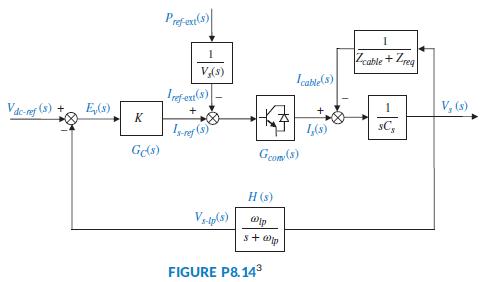Voltage droop control is a technique in which loads are driven at lower voltages than those provided
Question:
Voltage droop control is a technique in which loads are driven at lower voltages than those provided by the source. In general, the voltage is decreased as current demand increases in the load. The advantage of voltage droop is that it results in lower sensitivity to load current variations. Voltage droop can be applied to the power distribution of several generators and loads linked through a dc bus. In (Karlsson, 2003) generators and loads are driven by 3-phase ac power, so they are interfaced to the bus through ac/dc converters. Since each one of the loads works independently, a feedback system shown in FigureP8.14 is used in each to respond equally to bus voltage variations. Given that
Cs = Cr= 8,000 μF, Lcable = 50 μH, Rcable = 0.06 Ω, Zr= Rr=5 Ω, ωlp=200 rad/s, Gconv(s) = 1, Vdc-ref = 750 V, and Pref-ext = 0, do the following:
a. If Zreq is the parallel combination of Rr and Cr, and Gconv(s) = 1, find
![]()
b. Write a MATLAB M-file to plot and copy the full root locus for that system, then zoom-in the locus by setting the x-axis (realaxis) limits to -150 to 0 and the y-axis (imaginary-axis) limits to -150 to 150. Copy that plot, too, and find and record the following:
(1) The gain, K, at which the system would have complex-conjugate closed-loop dominant poles with a damping ratio ζ = 0.707
(2) The coordinates of the corresponding point selected on the root locus
(3) The values of all closed-loop poles at that gain
(4) The output voltage vs(t) for a step input voltage vdc-ref (t)= 750 u(t) volts
c. Plot that step response and use the MATLAB Characteristics tool (in the graph window) to note on the curve the following parameters:
(1) The actual percent overshoot and the corresponding peak time, Tp
(2) The rise time, Tr, and the settling time, Ts
(3) The final steady-state value in volts

Step by Step Answer:





